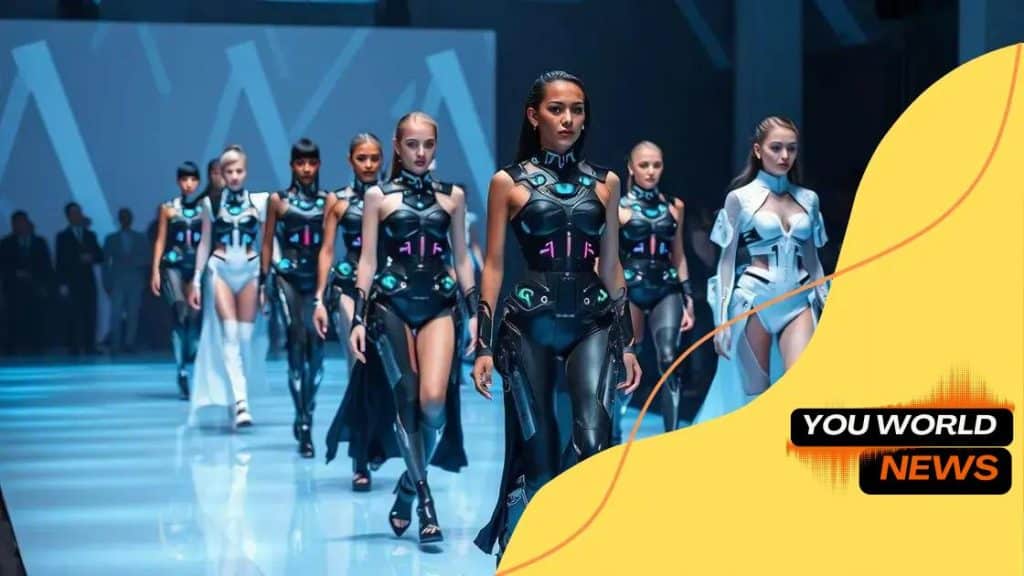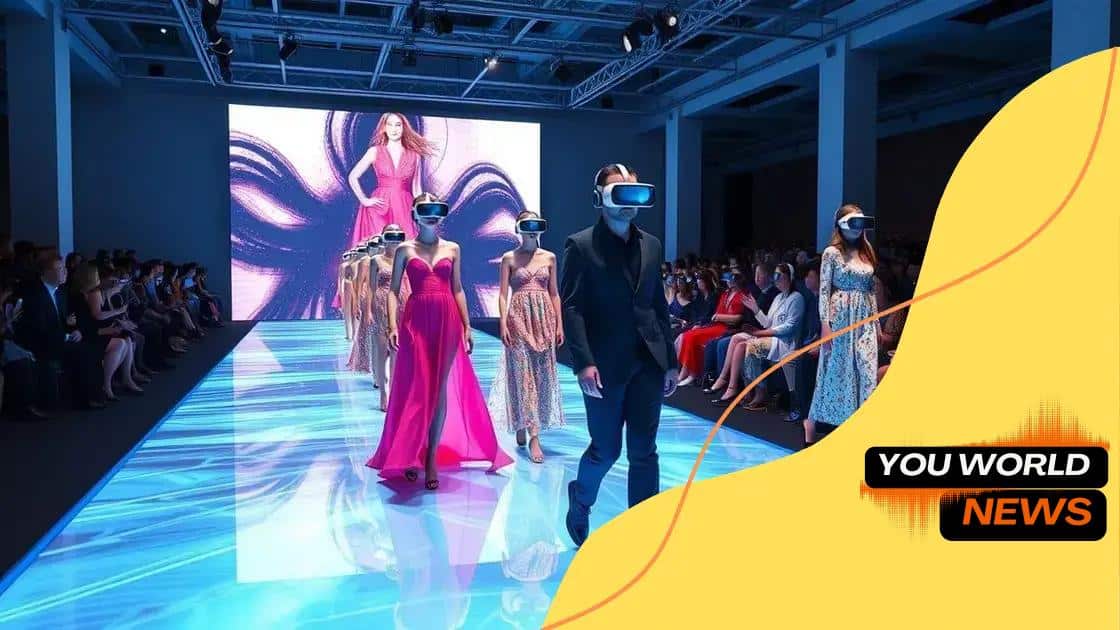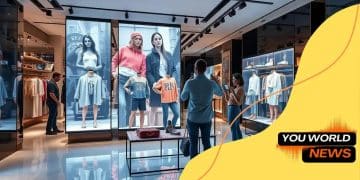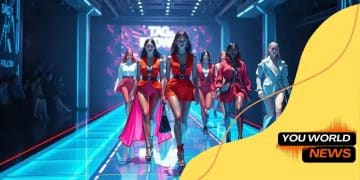The future of modeling in a tech-driven fashion world

The future of modeling in a tech-driven fashion world involves integrating AI, VR, and sustainable practices, creating new career opportunities and redefining industry standards.
The future of modeling in a tech-driven fashion world is not just a trend, it’s a revolution. As technology evolves, so does the landscape of how we perceive and create fashion. Have you ever wondered how these advancements might change your next shopping experience?
The impact of technology on fashion modeling
The impact of technology on fashion modeling is profound and multifaceted. From virtual modeling to augmented reality, these advancements are reshaping how we see and engage with fashion.
Virtual Models: A New Frontier
Virtual models are becoming increasingly popular in campaigns. These digital representations can be designed to show any style without the limitations faced by human models.
- Cost-effective
- Endless customization
- 24/7 availability
As brands seek to attract tech-savvy audiences, using virtual models is a strategic choice. Customers enjoy seeing how their favorite products look in innovative ways.
Augmented Reality Enhancements
Augmented reality (AR) is changing how shoppers interact with fashion. Rather than just browsing, customers can now try on outfits virtually through their devices.
- Enhances customer experience
- Reduces return rates
- Encourages purchases
This technology not only provides convenience but also adds a fun and engaging element to the shopping experience.
Furthermore, social media platforms are adapting to technology by allowing users to share their AR experiences. The blending of social interactivity with fashion is driving trends faster than ever.
As we look ahead, the relationship between technology and fashion modeling will continue to grow. With advancements like artificial intelligence and 3D printing, the possibilities are limitless. Imagine a world where fashion is not only seen but experienced in real-time, influencing trends at the speed of light.
How AI is reshaping the modeling process
How AI is reshaping the modeling process is a hot topic in the fashion industry. With innovations in technology, models can now utilize AI to enhance their work and creativity.
Creating Digital Models
AI now allows brands to create digital models that can wear their designs without the need for a physical photoshoot. This method saves time and resources.
- Cost-effective production
- Ability to experiment with styles
- Remove logistical challenges
These digital models can be adjusted easily, allowing brands to showcase countless designs without the usual constraints.
AI in Trend Analysis
AI can analyze vast amounts of data to predict trends before they hit the mainstream. By studying customer preferences, AI can help brands know what styles will resonate.
- Timely decision-making
- Better understanding of customers
- Increased relevance in campaigns
This means that fashion lines can be tailored more effectively to meet consumer demand—leading to better sales and satisfaction.
With advancements in machine learning, AI systems can even recognize patterns in consumer behavior, allowing for hyper-personalized recommendations. As shoppers, we enjoy experiences that speak to our tastes, and AI makes that happen.
The future of modeling looks exciting with these advancements. As designers and brands adopt more AI tools, the relationship between art and technology continues to evolve. What’s next in the modeling world? The innovations are truly limitless, paving the way for a more dynamic and inclusive fashion industry.
Virtual reality and its role in fashion

Virtual reality (VR) is playing an exciting role in fashion by creating immersive experiences for designers and consumers alike. This technology allows users to step into a virtual world where they can explore fashion in ways that were never possible before.
The Experience of Virtual Fashion Shows
Virtual reality has transformed how fashion shows are viewed. Attendees no longer have to be physically present to experience the excitement of a runway show. Instead, they can join from anywhere, making the experience more accessible.
- Global audience reach
- Interactive presentations
- Engaging storytelling through immersive environments
This shift changes the dynamics of how trends are shared and allows designers to showcase their collections effectively to a broader audience.
Personalized Shopping Experiences
With VR, shoppers can take virtual store tours, trying on clothes in a digital environment. This offers a unique way to see how outfits look without ever visiting a physical store.
- Enhanced decision-making
- Convenience from home
- Reduction of returns
Moreover, customers can visualize different accessories and styles, leading to an enjoyable shopping process. The blend of entertainment with retail is setting new standards in the industry.
As fashion continues to evolve, the integration of virtual reality will likely grow. Designers and brands that adopt this technology are likely to stand out. The imaginative possibilities with VR not only enhance creativity but also foster deeper connections between brands and their customers.
Sustainable practices in tech-driven modeling
Sustainable practices in tech-driven modeling are gaining importance as the fashion industry seeks to reduce its environmental footprint. Using modern technology, brands are finding innovative ways to create responsibly.
Eco-Friendly Materials
One major aspect of sustainability is the use of eco-friendly materials. Designers are now exploring fabrics made from recycled plastics, organic cotton, and other sustainable fibers.
- Reduces waste
- Minimizes environmental damage
- Promotes responsible sourcing
These eco-friendly options not only help the planet but also attract consumers who are increasingly conscious about their purchases.
3D Modeling and Virtual Samples
Instead of creating physical samples, brands use 3D modeling to design clothing. This method significantly cuts down on material waste by producing virtual samples that can be adjusted and reviewed before any fabric is cut.
- Less waste during production
- Faster design process
- Cost-effective solutions
This approach allows for quick adjustments and saves resources, making it a vital practice in sustainable fashion.
Moreover, tech-driven solutions like online marketplaces and digital fashion shows help reduce carbon footprints related to travel and logistics. These platforms create opportunities for designers to showcase their work without needing physical venues.
As technology continues to advance, the integration of sustainable practices in modeling will likely deepen. Brands that embrace these innovations not only contribute to a healthier planet but also cater to a more aware and environmentally conscious consumer base.
Navigating the future of fashion careers
Navigating the future of fashion careers requires adaptation to new technologies and market trends. With the rapid pace of change in the industry, professionals must stay informed and agile.
Emerging Roles in Fashion
As technology evolves, new roles are created. Careers that combine fashion with technology are on the rise, leading to exciting opportunities.
- Digital fashion designers
- Fashion data analysts
- Sustainability consultants
These positions are crucial for companies aiming to innovate and remain relevant in a tech-driven marketplace.
Skills for the Future
To thrive in these new roles, individuals must develop a unique set of skills. Understanding both fashion and technology is essential for success.
- Strong analytical skills
- Proficiency in design software
- Knowledge of sustainability practices
Moreover, soft skills like creativity, communication, and adaptability are equally important. The ability to collaborate across disciplines can lead to groundbreaking work in fashion.
Networking is also vital in this evolving landscape. Building connections within the tech community and fashion industry can open doors to new opportunities. Attending industry events and engaging on social media platforms can help establish valuable relationships.
As the fashion industry moves forward, the challenge is to balance creativity with technology. Professionals who embrace innovation and continue learning will thrive. The horizon is bright for those ready to adapt and grow.
FAQ – Frequently Asked Questions About the Future of Fashion Careers
What roles are emerging in the fashion industry due to technology?
New roles include digital fashion designers, fashion data analysts, and sustainability consultants, which are becoming increasingly important.
What skills are essential for future fashion professionals?
Key skills include strong analytical abilities, proficiency in design software, and knowledge of sustainability practices.
How important is networking in fashion careers?
Networking is vital as it helps professionals build connections within the industry, opening doors to new opportunities.
What impact does sustainability have on fashion careers?
Sustainability is reshaping the industry, creating demand for professionals who are knowledgeable about eco-friendly practices and innovations.





